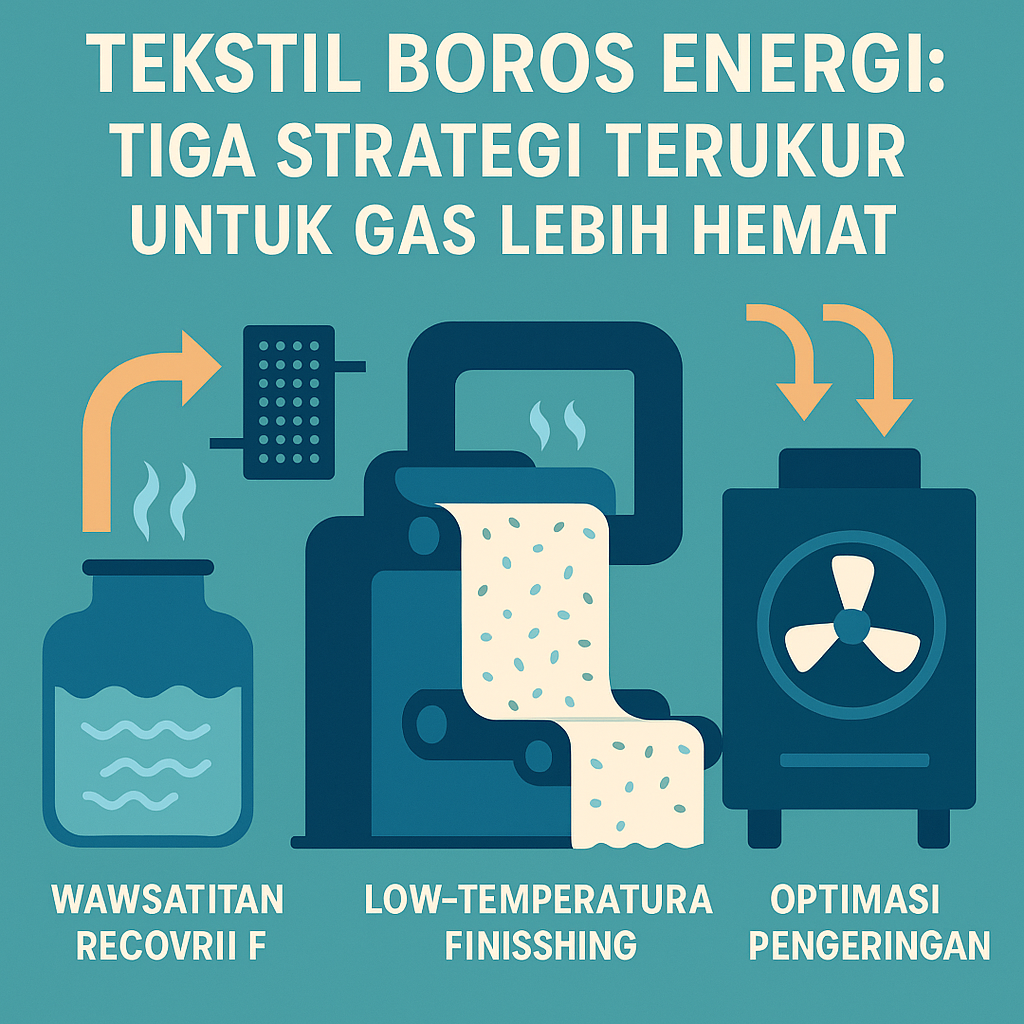Hot wastewater, cooler chemistry, and smarter dryers are reshaping energy use on the finishing line. Documented projects report double‑digit fuel savings and sub‑two‑year paybacks, with Indonesian mills citing ~28% efficiency gains.
Industry: Textile | Process: Finishing
Finishing plants routinely discharge baths at 70–90 °C — a river of wasted heat. Capturing it to preheat make‑up water is proving anything but niche: case studies show >10% natural‑gas savings in real mills www.renovisenergy.com www.renovisenergy.com, and projects commonly pay back in 1–2 years doczz.net.
The physics is blunt: raising boiler feed‑water even 6 °C saves roughly 1% of fuel, according to one industry guide (doczz.net). And there’s plenty of low‑hanging heat — from hot effluent to stenter exhaust.
Policy is nudging practice. In Indonesia, new green‑industry standards for fabric finishing explicitly encourage heat and water reuse; certified firms have seen ~28% higher energy efficiency on average (bbkb.kemenperin.go.id).
Wastewater and exhaust heat recovery
Installing wastewater heat exchangers or self‑cleaning spiral units (spiral heat exchangers are designed to shed fouling deposits) lets hot effluent preheat incoming process water, cutting boiler load. Plate‑type heat exchangers (a compact “plate and frame” device that transfers heat between two fluids) can deliver 3–5× the transfer efficiency of older shell‑and‑tube units (doczz.net), and spiral designs can capture heat despite fouling (doczz.net).
One mill installed a multi‑stage flue‑gas/water system that preheated 9,850 m³/hr of feed water, saving ~3.52 GWh/year (GWh/year: gigawatt‑hours per year) — about 12% of its natural gas use (www.renovisenergy.com). Another finisher recovered stenter exhaust heat via a flue‑to‑water exchanger (RC1), saving ~1.45 GWh/year (~36% of its process gas use) with an intervention payback of about 18 months (www.renovisenergy.com).
A broader review reinforces the upside: “a significant amount of water and energy can be conserved by adopting” these methods (www.researchgate.net www.researchgate.net). As a back‑of‑the‑envelope metric, 1 MJ (megajoule) recovered in feed‑water can cut roughly 0.1 MJ of boiler gas.
Projects typically pay back in 1–2 years (doczz.net). To keep exchanger surfaces clean where hardness is an issue, some utilities standardize simple pretreatment such as a softener to remove calcium and magnesium that drive scale formation; selection of supporting equipment for water treatment is site‑specific and tied to fouling risk.
Low‑temperature finishing routes
Traditional wet finishes run near boiling or at high heat. Emerging low‑temperature processes sharply reduce thermal load. Cold pad–batch (CPB, a room‑temperature dye fixation sequence where dye is applied by padding and cured during a long dwell) operates around ~20–30 °C and can “save up to 100% energy” while reducing water use 50–77% versus conventional dyeing (www.dorsali.com).
Ambient‑temperature plasma or ozone surface treatments (surface activation techniques using ionized gas or oxidants without bulk heating) require little water; industry sources claim plasma finishes can cut thermal energy needs by ~75% (www.dorsali.com). Foam finishing — applying dyestuff/chemicals as foam to replace most water — typically slashes drying energy 40–70% (www.dorsali.com). Where chemical dosing accuracy matters in these low‑liquor processes, plants routinely use a dosing pump for controlled addition.
Other methods — advanced catalysts or engineered binders — allow cure temperatures as low as ~135 °C (vs. 180–200 °C previously), saving 30–40% energy. A recent review emphasizes that pad–batch dyeing and foam application together can eliminate most heating/drying steps (www.dorsali.com). Quantitative data are often proprietary, but the cited industry studies report tens of percent gains in energy and water usage. Adopting low‑temp routes not only lowers gas/electric use but also simplifies equipment (e.g., no boiler needed). In Indonesia, fabric finishers evaluating such techniques for efficiency compliance report that switching to cold‑finish resins or foam dyeing could cut a finishing line’s fuel use by ~20–50%.
Stenter and dryer optimization

Drying and curing are the largest energy sinks. A stenter frame (also “tenter,” a heated conveyor that dries and width‑sets fabric) can gulp gas; one denim plant’s finishing unit accounted for an average ~68% of the mill’s natural‑gas consumption (www.scirp.org). Simply optimizing fan design and ducting — matching airflow to moisture load and avoiding excess exhaust — can cut dryer energy by ~30–35% (www.tekstilteknik.com.tr).
Other practical measures include improved chamber insulation, precise burner/O₂ controls (combustion tuning to maintain optimal oxygen levels), and scheduling runs to exploit residual heat. Many finishers now add multi‑stage heat recovery on the dryer itself. Bruckner’s “ECO‑HEAT” approach first passes hot dryer exhaust through an air/air exchanger to preheat incoming ambient or recirculated air — raising intake temperature and boosting drying rate (kohantextilejournal.com). A second stage can use an air/water exchanger to heat process water or building hot water (kohantextilejournal.com).
In practice, two‑stage recovery can cool exhaust from ~200 °C to ~50 °C, harnessing >1 MW of heat per line. One textile mill reported that after installing an exhaust‑to‑air heat exchanger on its stenter, it achieved a ~36% cut in gas use for drying with an ~18‑month payback (www.renovisenergy.com).
Benchmarks and combined impact
Heat‑recovery systems alone often save 10–20% of finishing energy, with typical payback around 1–2 years (doczz.net www.renovisenergy.com). Low‑temperature processes and better dryer control can each save ~30–70% on specific steps (www.dorsali.com www.tekstilteknik.com.tr).
A recent process‑optimization audit in a denim mill reported 34–40% lower energy use in key finishing machines, translating to an overall plant saving of ~17% with a ~4‑month payback (www.scirp.org). Indonesian industry is taking note: certified “green” textile finishers have documented ~28% improvement in energy efficiency (bbkb.kemenperin.go.id). Where upgrades touch water quality or dosing, utilities typically rely on standard kit — from scale inhibitors in recirculating loops to supporting equipment for water treatment — to maintain stable operation.
Taken together, these data‑backed measures form a roadmap for a finishing line to cut fuel use, lower CO₂, and meet modern efficiency standards. Integrating waste‑water exchangers to preheat make‑up water can often reduce steam/fuel use by double‑digit percentages (e.g., >10% natural‑gas savings in the Renovis cases: www.renovisenergy.com www.renovisenergy.com).
Sources: Authoritative industry studies and case reports (doczz.net) (www.renovisenergy.com) (www.renovisenergy.com) (kohantextilejournal.com) (www.dorsali.com) (www.tekstilteknik.com.tr) (www.scirp.org) (bbkb.kemenperin.go.id) (doczz.net).
